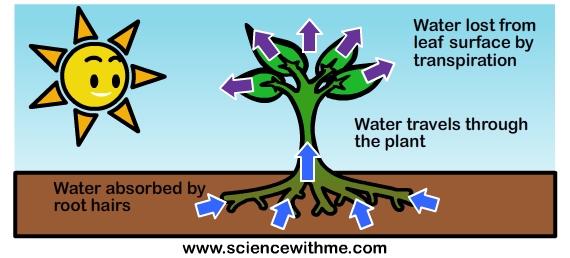Like you and all other living organisms in the world, plants need water and nutrients from the environment in order to survive.
Different parts of the plant are involved in transport or movement of water and nutrients. These parts are the roots, the stem and the leaves. The transport system of plants works similar to your circulatory system. However, plants do not have a pumping organ like the heart. Therefore, they have to make use of simpler mechanisms in order to allow the transfer of a substance from one place to another.
What are the three levels of transport in plants?
Transport in plants occurs at three levels. The first level is cellular transport, whereby solutes and ions are transferred from one cell to another. This typically occurs through diffusion and osmosis. With osmosis, water flows from an area of high solute concentration to an area of low solute concentration. The second level is the absorption of water and nutrients from the soil by the roots. In general, as surface area increases, absorption also increases. Because of many root hairs or extensions, a plant’s roots actually have a high surface area. Just think about this: if drought or water scarcity sets in, a plant which has lots of roots would have a greater chance of survival compared to a plant with a few roots. This is explained by the fact that a plant with many root extensions has greater absorptive capacity. It is the reason why during the summer, grasses in your backyard wilt easier than big trees. The third level of transport is the transfer of water and nutrients from the root to the highest part of the plant even without a mechanical pump. Among tall trees, water and nutrients, also called xylem sap, become transported along a length of about 100 meters. This is made possible through a process called transpiration.

What is xylem?
The xylem is a tube and transport system, that helps water and dissolved substances go to different plant parts. The dissolved substances are minerals from the soil and food previously stored in the stem and roots. The tubes are connected end to end. Xylem transport is said to be unidirectional, which means transport occurs in a single direction. If you cut the lower end of a plant stem and place it in a water-and-dye solution for a few minutes or hours, the stem would absorb the solution and somehow retain the dye. If you examine the stem under a microscope, you would see that the dye is located in the xylem cells. Xylem cells are called vessel elements, tracheids and parenchymal cells. Every year, a tree gains new xylem because the old xylem dies. When you see the cut trunk of a tree, old xylem tubes appear like concentric rings.
What is phloem?
The phloem is another transport system in plants that carries food or sucrose, a type of sugar, from the leaves to other plant parts. Sucrose is actually an end-product of photosynthesis. Up to 30% of phloem sap is made up of sucrose. Phloem transport is bidirectional, which means that transport occurs in two directions. In flower-bearing plants or “angiosperms”, the special cells in phloem are called sieve-tube members. Phloem is always alive, which is why it does not form rings like those of xylem.
What is translocation?
Basically, phloem sap moves from a sugar source (leaves) to a sugar sink (like roots). The phloem loading and unloading process is called “translocation”. During translocation, when phloem is loaded with sucrose, water flows into phloem through osmosis. When the phloem sap reaches the sugar sink, unloading occurs, which means that as sugar goes out, water also flows out. Water is then recycled through xylem transport.
What is transpiration?
Transpiration is the process of water loss from the stomata (plural for stoma or leaf opening) in plant leaves. However, it also occurs in flowers, stems and roots. It is similar to evaporation. Transpiration or water loss allows carbon dioxide to get into the leaves from the air. Remember that carbon dioxide is needed for photosynthesis. Aside from allowing the plant to get carbon dioxide from the air, transpiration also enables xylem transport. Note that water flows from an area of higher water (hydrostatic) pressure to an area of lower pressure. Because of transpiration, the upper parts of the plants have a lower amount of water and a lower hydrostatic pressure. Therefore, water is able to flow from the roots to the upper parts of the plant, through the xylem tubes. However, there are times that transpiration is not necessary or not possible. For instance, during the night, transpiration stops. Additionally, the plant detects when too much water is lost. To prevent further water loss, the stomata close, effectively shutting down transpiration.
